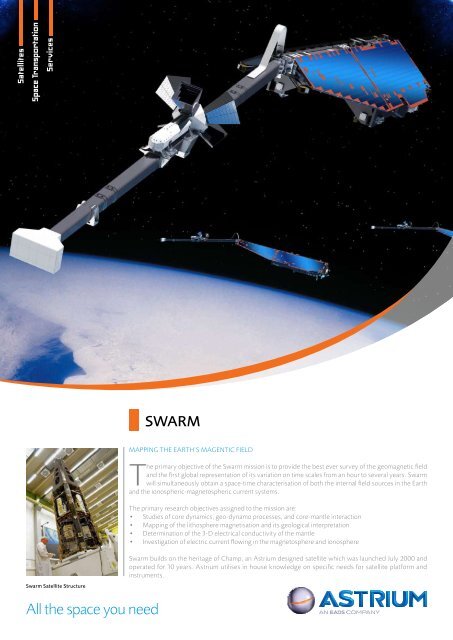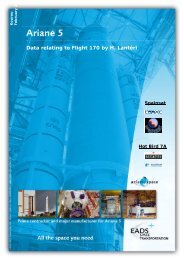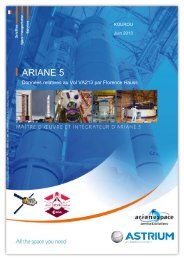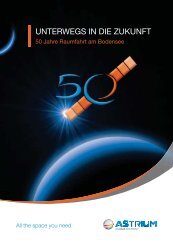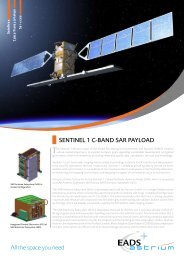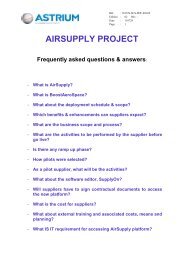Download Fact Sheet (PDF) - Astrium - Eads
Download Fact Sheet (PDF) - Astrium - Eads
Download Fact Sheet (PDF) - Astrium - Eads
You also want an ePaper? Increase the reach of your titles
YUMPU automatically turns print PDFs into web optimized ePapers that Google loves.
swarm satellite structure<br />
all the space you need<br />
swarm<br />
Mapping the earth’s Magentic field<br />
the primary objective of the swarm mission is to provide the best ever survey of the geomagnetic field<br />
and the first global representation of its variation on time scales from an hour to several years. swarm<br />
will simultaneously obtain a space-time characterisation of both the internal field sources in the earth<br />
and the ionospheric-magnetospheric current systems.<br />
the primary research objectives assigned to the mission are:<br />
• studies of core dynamics, geo-dynamo processes, and core-mantle interaction<br />
• Mapping of the lithosphere magnetisation and its geological interpretation<br />
• determination of the 3-d electrical conductivity of the mantle<br />
• investigation of electric current flowing in the magnetosphere and ionosphere<br />
swarm builds on the heritage of champ, an astrium designed satellite which was launched July 2000 and<br />
operated for 10 years. astrium utilises in house knowledge on specific needs for satellite platform and<br />
instruments.
7337tl oct © 2010 <strong>Astrium</strong>, images © 2010 ESA, © 2010 <strong>Astrium</strong><br />
Customer european space agency<br />
Mission geomagnetic field measurement<br />
Orbit polar low earth Orbit<br />
Spacecraft swarm consists of 3 satellites in a constellation flying at altitudes between<br />
490 and 300km<br />
Payload • asM (absolute scalar<br />
• acc (accelerometer)<br />
Magnetometer)<br />
• lrr (laser retro reflector)<br />
• VfM (Vector field<br />
• star tracker system<br />
Magnetometer)<br />
• gps receiver l1/l2<br />
• efi (electrical field instrument<br />
Features • Magnetically clean spacecraft • 6Mbit/s s-band downlink<br />
• deployable boom (4m) • l1/l2 gpsr<br />
• Ultra-stable optical bench • earth oriented safe mode<br />
• high ballistic coefficient<br />
Launch Mass 1500kg<br />
Dimensions height = 1m, Width = 1.5m, depth = 9m<br />
Launch Date 2012<br />
Mission Duration 4 years<br />
Status cdr passed<br />
<strong>Astrium</strong> Responsibilities • prime contractor<br />
• pcdU and solar array<br />
• thermal/mechanical platform • Optical Bench assembly<br />
• system ait/V<br />
• Mission analysis<br />
Key Features:<br />
the swarm system design is based on astrium’s long standing experience in magnetically clean satellites,<br />
in missions including isee-B, Ulysses, cluster and champ. swarm will allow the permanent monitoring of<br />
earth’s magnetic field from low earth orbit to continue.<br />
the optical bench assembly houses a vector field magnetometer and three star cameras, to give a precise<br />
field measurement where the instrument position is known. the magnetometer and star cameras are separated<br />
by 0.5m to prevent the magnetic fields of the star cameras from interfering with the magnetometer, and they<br />
are connected by a stable carbon-fibre/ceramic structure. this optical bench is stable to one arc second, so<br />
accurate that it cannot be measured under gravity and must undergo additional testing and modelling to<br />
prove the assembly.<br />
the three satellite constellation allows the magnetic field to be measured in several locations at the same<br />
time. to date, changes in measurements could be because the field varies over time. swarm’s multiple<br />
simultaneous measurements will reveal variations due to location alone.<br />
the swarm design allows the spacecraft to fly at low altitudes for extended periods with a low fuel demand<br />
due to a low ballistic coefficient. this is when the cross sectional area is small but the mass is large. the<br />
swarm design needs a mass of 500kg, and unlike other spacecraft where mass is minimised as much as<br />
possible, the swarm satellites must reach their target of 500kg or any difference will be made up by extra<br />
weight added.<br />
for more information please contact:<br />
albert Zaglauer, swarm project Manager<br />
earth Observation & science division<br />
astrium Gmbh<br />
88039 friedrichshafen<br />
germany<br />
phOne: +49 (0) 7545 8 4018<br />
faX: +49 (0) 7545 8 3376<br />
eMail: albert.zaglauer@astrium.eads.net www.astrium.eads.net<br />
swarm Optical Bench<br />
INDUsTrIaL TEam<br />
astrium<br />
Zarm<br />
aLTraN<br />
GFZ<br />
Xperion<br />
aBsL (aEa)<br />
astrium<br />
scisys<br />
IGG<br />
marotta<br />
DTU<br />
rUaG-a<br />
sIEmENs<br />
Oerlikon<br />
Clemessy<br />
rUaG<br />
Tas-I<br />
VZLU<br />
Critical software<br />
ssBV<br />
Bradford Engineering<br />
TEChNOLOGICa<br />
GmV<br />
Patria<br />
rUaG-s<br />
Boostec


